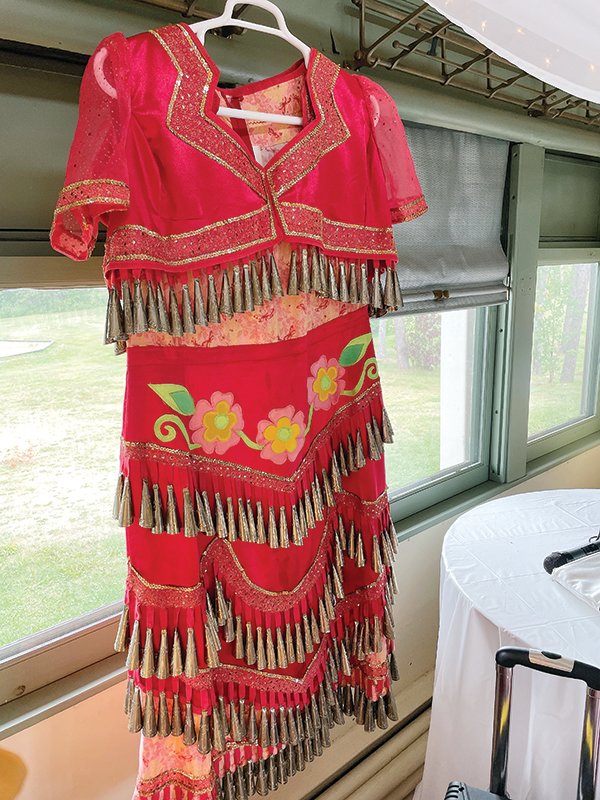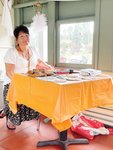Support the Timberjay by making a donation.
History Talks on Main Street series kicks off with the story of the jingle dress
TOWER- The origin of the jingle dress traces back to a dream…and Copenhagen tobacco tins.Tower-Soudan area residents got a look into our area’s history and culture on Aug. 5 in a talk …
This item is available in full to subscribers.
Attention subscribers
To continue reading, you will need to either log in to your subscriber account, below, or purchase a new subscription.
Please log in to continue |
History Talks on Main Street series kicks off with the story of the jingle dress
TOWER- The origin of the jingle dress traces back to a dream…and Copenhagen tobacco tins.
Tower-Soudan area residents got a look into our area’s history and culture on Aug. 5 in a talk hosted by the Tower-Soudan Historical Society. The talk was held in Coach Car 88, the renovated train car that also serves as a meeting spot, and was the first in a series of three history talks offered this summer. The final talk will be held on Tuesday, Aug. 24 at 2:30 p.m. at Good Ol’ Days, with owner Randy Semo talking about the history of his bar, and other stories about the olden days in Tower when there were over 20 bars in the city.
Adrienne Rose Whiteman, a Bois Forte Band member from Nett Lake, related a variation of the Ojibwe story about the origin of the jingle dress in which a grandfather had a granddaughter who was very ill, and he prayed for a way to heal her. He was very distraught and worried about her, her well-being, her body, her soul, every part of her.
In the dream, four ladies came to him in dresses with metal cones on them. They told him if they danced for his granddaughter and did the ceremonies that go with it, she would be healed.
His wife put the dress together according to his description and then asked, “How are we going to dance in this dress if it’s a dancing dress?” He replied, “Well, you have to do a sidestep, which is like this.’”
Whiteman, whose given name of Gey zha gunni gook means “traveling spirit,” showed the attendees what the dance step looked like as she finished telling the story.
“And then you follow,” she said. “All the ladies line up in a circle with that dress on and dance in a circle, and none of the ladies will go in front of another lady because you don’t want to break that circle of healing. That’s how the jingle dress originated.“
But, why the Copenhagen tins?
It’s a testament to the importance of tobacco to the Ojibwe people.
“Tobacco is like our cell phone, when you want to be heard,” Whiteman said. “It is our money, our telephone with any spirit, living or other.”
When asking for spiritual guidance, tradition holds that there must be a tree, rock, or lake where tobacco will be placed for the prayer. In the morning, it must be the sunrise side, and in the evening it must be the sunset side.
The Ojibwe belief is that everything has a spirit and must be blessed by ceremony, Whiteman said.
Whiteman elaborated that even the items displayed in a museum exhibit have to be blessed and recognized by going through annual spring and/or fall ceremonies.
“The way it was explained to me was that if you were put behind a glass, for everybody to view and everything, you would also want to be handled correctly, in the ceremony.” Whiteman said. “It’s also to let the spirit know that it’s okay to be in there.”
The jingle dress is no exception, and also must go through a ceremony and be blessed. Whiteman has not yet taken the step to make a traditional jingle dress for herself because she doesn’t yet feel ready to perform the ceremonial healing dance.
“I have not asked for it yet. I want to be able to have a full knowledge (of) what power (the dress) has for me and my healing, and in my being able to heal other people by dancing in this dress,” she explained.
To Whiteman, it is empowering to share this knowledge with others outside of the Ojibwe culture.
“I am proud of what I know, and have always enjoyed learning about other cultures myself,” she said.
Her given name does mean traveling spirit, after all.









